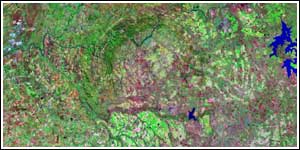Vredefort Dome
 World Heritage site
World Heritage site
Year inscribed: 2005
Location: Free State and North West, 26′ 51′ 36″ S 27′ 15′ 36″ E
Type: Natural heritage
It is speculated that Some 2-billion years ago a meteorite 10 kilometres in diameter hit the earth. This took place about 100km southwest of Johannesburg, thus creating an enormous impact crater. Near the town of Vredefort in the Free State, is an area known as the Vredefort Dome.
It is considered that the meteorite, larger than Table Mountain, caused a blast of energy measured at a thousand-megaton. This impact would have vaporised about 70 cubic kilometres of rock – which in-turn may have increased the earth’s oxygen levels to a degree that allowed for the development of multicellular life.
The world has about 130 crater structures considered to be of impact origin. The Vredefort Dome is placed amongst the top three, and is the oldest and largest clearly visible meteorite impact site in the world.
The original crater which has eroded away with time, is considered to have been between 250 to 300 kilometres in diameter. It is seen as larger than the Sudbury impact structure in Canada, which is about 200km in diameter.
With Vredefort at 2-billion years old, it is far older than the Chixculub structure in Mexico which, which has an estimated age of 65-million years, and is considered the site of the impact which led to the dinosaurs extinction.
The original impact scar of Vredefort measures 380km across and consisting of three concentric circles of uplifted rock. They are considered to have been created by the rebound of rock below the impact site when the asteroid hit. Erosion has been the cause of most of these structures to have faded away and are therefore no longer clearly visible.
The inner circle however is still visible and measuring 180km, can be seen across the beautiful range of hills near Parys and Vredefort. This is the area which has been listed as a World Heritage site.



